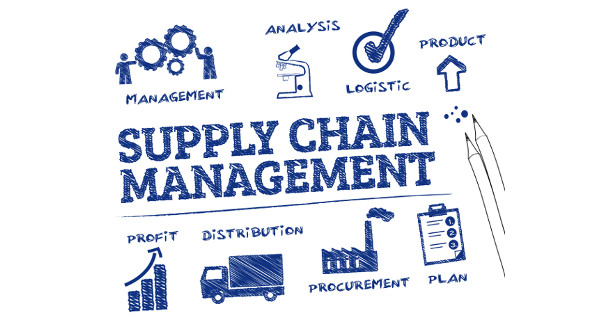Introduction On Supply Chain Management
Without an effective supply chain, goods can’t be reached to the customer on time. So, supply chain means a lot. In context of organization, supply chain provides raw goods from the supplier to the production area for their conversion into finished goods. Thus, with this start, it is portraying that every report is formed by taking some aim and objective in mind. In the same way, this report is also formed with the aim of maintaining and managing the relationship between members of supply chain and another focus is on describing the importance of trust in the relation of supply chain and organization. Before heading towards the objectives of this report, concept of supply chain will be discussed. Supply chain is the only tool which provides goods from the manufacturing area to the retail or selling area (Anghileri, 2011).

As the organization is heading towards the international market, so it is necessary for the organization to maintain smooth flow of supply of goods and services to the organization. Then only organization will sustain in the international market. Therefore, the challenges that an organization face in the supply chain in international market will be discussed in this report (Castaldo, 2007).
Later on, conversation will be adhered on the relationship that has to be maintaining with supply chain. It is as much important as raw material important for an organization. It is needed to say that organization has to maintain a healthy relation with their supply chain members. These results in delay, cost reduction etc. if maintains a good relation with supplier. At last role of trust in their relationship will be discussed. It is also considered as one of the important part in developing a healthy relation and then a conclusion will be drawn at the last (Crocker and Emmett, 2012).
CONCEPT OF SUPPLY CHAIN MANAGEMENT
There is infinite definition on supply chain management. As this topic is so vast and can’t be explained in few lines, still researcher has defined supply chain management, as it is the management of material and the flow of information being supplied to the organization and to the customer to provide a high degree of customer satisfaction at the lowest price. Supply chain management works with the support of whole team and that’s why it requires the commitment from their supply chain members to work closely and to co-ordinate order that has been placed, accepting or taking order and fulfilling at the given time with full effectiveness (Delfmann, 2007).
According to La Londe (2000) proposed that supply chain is a set of firm that passes material forward. In the words of La Londe, it’s quite obvious that not a single supplier is only involved in supply chain producers, transporter, inventory manager, retailer, whole seller and customer are involved in the concept of supply chain (Fawcett, 2008).
Organization’s role in supply chain
To gain the competitive edge in the world of competition, organization has to think beyond tier limits. One of the fields that organization has to concentrate carefully is on the field of Supply Chain. Organization plays a vital role in the field of supply chain. Many organizations are seeking new approaches to compete through a competitive supply chain strategy (Machuca and et. al, 2010). Recent research validates the fact that supply chain improvements are achieved when organizations recognize the importance of SCM. The five area where decision has to be taken in context of supply chain are:
- Production
- Inventory
- Location
- Transportation
- Information
Production:
The fundamental approach towards the supply chain by the management is to how to sort out the trade-off between responsiveness and the efficiency. In order to speed up the supply chain process organization should built to accommodate two approaches to manufacture are product and functional focus. Another action relating to supply chain by organization is that they can use any of the three approaches i.e. stock keeping unit, job lot storage and cross-docking. In this area an organization should take care to make effective the supply chain (Mentzer, 2001).
Assignment Prime is an online assignment writing service provider which caters the academic need of students.
Get Best Pricing Quotes Free Samples Email : help@assignmentprime.com Order NowInventory:
Another important field where decision can be taken regarding supply chain is inventory. Inventory is widespread throughout the supply chain and includes everything from raw material to work I progress to final products which is called as finished goods. In respect of inventory organization are liable to take three decision regarding holding of inventory they are cycle inventory, safety inventory and seasonal inventory (Modi, 2006).
Location:
Location defines the geographical area from where the supply chain performs their operation. It defines all the responsibility area and their facility location from where activity should be performed. An organization to gain economies of scale and efficiency must decentralize their activity close to customers and suppliers. It is given so much importance because location decision has strong impact on the cost and performance of supply chain (Peng, 2011).
Transportation:
It refers to the movement of everything i.e. from raw material to finished goods from different location, area and facilities in a supply chain. Transportation is also a matter of concern that which source should be chosen, whether land, air or water. It also aid to the cost of product. If fails to decide the effective mode of transportation may results in heavy loss (Zuckerman, 2002).
Information:
In supply chain not only tangible goods are transferred to production or manufacturing department but information also supplied to manufacturer, producers, retailers, whole seller and customer. This information are then used for taking future decision and used for co-coordinating daily activities. With the help of information future demands can be anticipated by the organization. So supply chain is also works in this area (Zuckerman, 2002).
CHALLENGES OF SUPPLY CHAIN MANAGEMENT INTERNATIONALLY
Aim of every company is now to get their footprints in the international market, in which many of them succeeded to do so. But the major problem now they are facing is to manage and maintain the supply chain internationally. It seems so typical and tedious work in view of an organization. This part of this report will provide discussion on the challenges of supply chain that organization facing internationally, they are performing globally:
- Volatility and Uncertainty increasing in Supply Chain: today's market demands for higher market transparency and elasticity of price led to lower down the customer loyalty. It is seen that commoditization reduces the differentiation between customer and business to business environment. As far as this report is concern, researcher gone through various respondents and many of the respondents said that there lies a poor forecast accuracy and volatility in demand and supply. These two factor act as a barrier in the supply chain in present market of international that they are facing. It is said that increase in commoditization are not at all affected even at the time of recession. In the international market it is seen that customers are continuously looking for various alternative of supply resources, which led business to business demand curve move up and down rapidly and dramatically (Wilding and Humphries, 2006).
- Differences: Here researcher is talking about differences of time, language and culture differences within the supply chain. Organization that performs in the international market faces such kind of challenges which is not for some period but becomes challenge for future time period also. Goods that demands, their time may differ from country to country in supplying goods from other countries. So to synchronize time with one country to another country, organization has to think in advanced. Another one is language difference. To overcome this organization hire specialist who knows respective language of supplier whether it may be German, French, and Chinese etc. so as to maintain flow of goods from them. Last one is cultural differences in international market (Youn and et. al, 2010).
- Future market depends on international customer which demands for increase in supply chain globally and need to be managed: To secure the market and growth in international ground, it is necessary to grab international customer and also to increase or maintain the supplier networks globally. From the research, data that is found is that 85% of companies feel complexity in their supply chain and now they are saying that they will grow up significantly in 2014. One of the major challenges seen is that many companies go for outsourcing which led to lower down manufacturing location and in the number of supplier that they were working with. So that's why companies are concentrating in global customer. It is said that supply chain is key to success. To overcome this challenge companies have to build supply chain partners, manufacturing facilities and distribution centers as much as economically possible (Christopher, 2012).
- Complex approach in supply chain: In international market, method of supply goods takes longer period of time as compare to domestic one. Along with longer time period it also involved a complex procedure of supplying goods from one country to another because taxes that are levied has to be paid, rules of exporting has to be followed of the country from where goods are coming from and on the other end rules has to be followed of that country where goods will be dropped. This all collectively makes the process so complex ad time consuming (Handfield, 2002).
- Difficult to maintain equilibrium between stocking and demand: International market is so sensitive in nature. That’s why no organization takes risk of higher stocking. But what will happen if demands for a product suddenly rise? At that time it will difficult to maintain stock of each variety. So a supply chain manager should be smart enough to bridge this gap and try to sort out this challenge (Handfield, 2011).
- International market dynamics demands regional and cost optimized supply chain: In the present scenario of international market, it is demanded that customer requirements should be fulfilled as per their expectation. Another thing that require is the necessity that require giving neck to neck competition. These two things tailored supply chain management and also product offerings. In international end-to-end supply chain cost optimization will be critical. In order to compete the challenge in international market to reduce supply chain cost outsourcing were viewed as a main lever. It is expected that if they do so gross margin will increase over next two years not with the help of price but with the help of reduced supply chain cost (Harrison and Ganeshan, 2000).
- Sorting out challenge of Transport: Transport is one of the crucial factors which either increase or decrease the price or providing fast or slow supply of goods. Means challenge of choosing effective means of transportation which gives both benefit i.e. cost effective and faster ((Machuca and et. al, 2010))
- Risk involved in end to end supply chain in international market: In the field of supply chain risk and opportunity go side by side. Risk and opportunity management span entire supply chain from demand planning to expansion of manufacturing capacity. To complete this process it is mandatory to aid supply chain partners. During the time of recession, it becomes so typical for supply management in terms of financial risk. So to overcome this problem, companies have shifted all the risk on to the shoulder of supplier. This approach is called end to end approach in managing risk at both end of the supply chain. In order to gain competitive advantage in international market, companies are now planning to demand only that material which is required to full fill firms order. This helps in reducing the cost of inventory and also reduces risk involved in inventory. By doing so all responsibility comes on to supplier (Supply Chain Management: challenges and solutions, 2013).
- Supply chain are not properly integrated and empowered: In order to dominate challenges of supply chain in international market, significant support is required across all supply chain function. Support here demands for having an empowered supply chain and highly integrated supply chain in an organization. From research it is concluded that above four challenges get full filled if improved level of integration and empowering supply chain are there in an organization in international market. In international to make supply chain effective, organization is now hiring chief supply chain officer who will manage and will be held responsible for end to end supply chain. By doing so they can easily able to retain supply chain talent in an organization, this should becomes only focus for every organization (Supply Chain Relationships, 2011).
RELATIONSHIP FORMED BETWEEN SUPPLY CHAIN MEMBERS AND THEIR IMPORTANCE
Supply chain management largely depends on the kind of relation that an organization developed with them. In every field of organization has to maintain healthy relation the can be like stakeholder, investors, customers, society and one of the important field with which they have to maintain their relationship is with supply chain members. They are the same who provide goods, services and information into the organization, not only in organization but also to customers, producers, retailer and wholesalers. The main essence that comes out with this conversation is that relationship plays an important role in an organization for their smooth flow of operation and for their efficient performance (Bergh and et. al., 2011). Coming back to main topic of this report, we are talking about supply chain and kind of relation that has to be developed is:
- Vertical Relationship
- Horizontal relationship
These two are most basics types of supply chain relationship that are operated in an organization. Brief discussion of this relation is as under:
Horizontal Relationship: In supply chain relationship, this relationship is developed between other firms in the same industry. This relationship is also known as parallel relationship or coordination relationship. In this an agreement is made between two firms in respect of supplying material, in respect of support, in respect of flow of information etc. in this relationship involves two people, group, department, or firm. In horizontal relationship it includes both formal and informal components (Carter and et. al., 2011). Formal aspects in horizontal relationship include discussion on work, floating of information and encouraging communication. In supply chain these all are very necessary in respect of communication that what kind of order is required, what type of information required and what work has to be perform to get goods, services and information? By maintaining these aspects a healthy relation can be formed with supply chain members (Carter and et. al., 2011).
In context of informal aspect in horizontal relationship, it involves peer to peer relationship by providing social opportunity and also to encourage team building activities. These let them feel so relaxed that organization is interested in them other than work also. This informal aspect is done outside of organization environment. Let’s take this in supply chain, if members of that department are encouraged in social activity along with organization and create informal relationship with them will definitely strengthen their relationship (Fedorowicz and Ghosh, 2008).
Vertical Relationship: Vertical relationship is also known as buyer and seller relationship. These refer to traditional linkage between firms in supply chain such as relationship with firms, retailers, wholesalers, distributor, and manufacture and material supplier. These relationship takes place when two people interacts that are on differential position i.e. when a production department puts an order to supply chain members for material required for production. These are two different departments in an organization and two members or a group is involved in this process (Hingley, 2001). Vertical type of relationship develops through upwards and downward internal communication. Upward communication takes place when organization puts an order for material to supplier for their production. On contrary, downward communication takes place when supplier passes information or goods or services to an organization against their order. That becomes downward communication (Kotzab and et. al, 2011).
Importance of Relationship
If organization able to develop a healthy relationship with their supply chain members, they will definitely enjoy some advantage for that. Building a healthy relation may leads to following benefits:
- True collaboration: Benefits that can be enjoyed by maintaining healthy relation led to joint forecasting in respect of time and size of delivery. Task of forecasting is quite difficult but because of healthy relation supplier also provide support to an organization in forecasting future demands and supply of products (Laeequddin and et. al, 2010).
- Less delaying of materials: Results of maintaining healthy relation with supply chain members led to less delaying in supplying of goods or services or information to organization. This gives a smooth flow of production.
- Cost minimization: If organization intelligently maintains healthy relation with their supply chain members on contrary organization will get their material at lower cost not too high but a bit can be lower from the side of supply chain members. This all will happen because of good and healthy relation.
- Improved performance: Fails to maintain healthy relation with supplier results in poor performance from supplier i.e. inferior supply of goods and less reliable information to organization. So as to improve performance in respect of supplied material there has to be a healthy relation between them (Larson and McLachlin, 2011).
- Bolstering the brand: It is seen that reputation of brands reflects customer loyalty. Managing supply chain relationship provides new business opportunity. They enable them to reshape tier organization, further new channels can be introduced, and new markets can also be developing through more intimate relationship with supplier.
- Just-in-time approach: Managing supply chain relationship enables an organization to get their material on time by their supplier whenever they demands. This process is called just in time approach. Benefit of this approach can be enjoyed only when there is sound relation with supplier (Pettit and et. al., 2013).
ROLE OF TRUST IN RELATIONSHIP
Trust is the sense of mutuality and loyalty between two parties. Inculcating trust between two parties led to strong bonding. Trust is considered as one of the most critical factors in a committed and collaborative relationship between supply chain partners. By showing trust in supply chain relationship, it can improve the chances of developing successful relationship with supply chain members. Fails to develop healthy relationship then organization will bear their cost in the form of rise in cost of material and in poor performance by their supply chain members (Delfmann, 2007).
For every organization it is necessary to bring trust in their every relationship, especially with supply chain, in order to be flexible and agile. It is said that maintaining trust in relationship is so harder as both parties vary in context of culture, mind set, level etc. this led them difficult to maintain trust in their relationship. Role of trust in supply chain relationship based upon commonalities among partners. To maintain trust in relationship high amount of patience is require and this can take time to develop it properly. The role that trust plays in relationship is that it let other members to think that their fellow members are not exploiting them in any way though it also involves risk and interdependence in a supply chain relationship but they are working together so they have to mould tier mind in a positive side. With such thinking gives sound results i.e. a development of honesty and openness to be successful (Crocker and Emmett, 2012).
The main role that trust plays in supply chain relationships is they develop honesty, loyalty, fairness, openness and competency. To create a trust organization should carefully take their step i.e. to create a trust they should not invest more or low. Trust is basically created with honesty and loyalty not with money. It is apparent that trust only exist when both parties thinks same that they exist. This gives sense that supply chain members thinks that they are important for an organization and this led them to share information freely and supply goods on time. This is the role that trust plays in relationship with supply chain members (Castaldo, 2007).
CONCLUSION
From the above report it is concluded that without a supply chain management organization does not exist anywhere. In above report it is explained that what supply chain management is and what is their importance in organization and what are their impacts? It is concluded that without an effective supply chain management organization will not able to maintain their flow of production on a regular basis. Supply chain is the only source through which goods, services and information flows from supplier to manufacture, producers, retailers and customers. From the research it is understood that organization are switching their path from domestic market to international market to enjoy higher amount of profit and customers. But to gain such position supply chain plays an important role. There exist some challenges that have to be faced in international market by an organization. Challenges are discussed in above report i.e. complex procedure of supply chain, difficult to maintain equilibrium between stocking and consumer demands, differences in language, time and culture etc. these has to be sort out intelligently to dominate international market.
These challenges can be sort out by developing healthy relation with supply chain members. Relationship is the whole and soul in supply chain. Better will be the relation with supplier smoother will be the flow of goods and services and if trust is there in this relationship than for sure organization will overcome all challenges in international market. so overall to maintain smooth flow of goods and information from supplier healthy relationship and trust has to be bring between organization and supplier.
REFERENCES
- Anghileri, F., 2011. The Organizational Role of the Supply Chain Manager. Lambert Academic Publishing.
- Castaldo, S., 2007. Trust in Market Relationships. Edward Elgar Publishing.
- Crocker, B. and Emmett, S., 2012. The Relationship-Driven Supply Chain: Creating a Culture of Collaboration Throughout the Chain. Gower Publishing.
- Delfmann, W., 2007. Managing Supply Chains: Challenges and Opportunities. Copenhagen Business School Press DK.
- Fawcett, 2008. Supply Chain Management. Pearson Education.
- Machuca, J. and et. al, 2010. Managing Global Supply Chain Relationships: Operations, Strategies and Practices. IGI Global.
- Mentzer, T. J., 2001. Supply Chain Management. 2nd ed. SAGE.
- Modi, B. S., 2006. Role of Supply Chain Capabilities in Organizational Innovation Efforts. Indiana University.
- Peng, G., 2011. Inter-Organizational Information Exchange, Supply Chain Compliance and Performance. Wageningen Academic Pub.
- Zuckerman, A., 2002. Supply Chain Management. Capstone.















